The Freaks and the Runts: Fun with Hitting Mechanics
If you have read any of my previous hitting articles, it’s no secret I think swing mechanics are an underappreciated and improperly utilized aspect of the evaluation of professional hitters. For me, looking at a player’s swing can tell you a lot about what kind of hitter he is, and a hitter who perfects his swing can overcome most limitations to his long-term success (within reason, of course).
Now, nobody has a perfect swing, and everyone has weaknesses that can be exploited. There are also hitters who get away with flawed swings via superior athleticism and/or hand-eye coordination. Too easily, though, this is used as the easy way to dismiss what others say about hitting mechanics or do themselves. If you don’t agree with how Pickles Dilhoeffer swings a bat, but he gets good results, he’s a freak. That way, you never have to question your own understanding.
I spend a lot of time looking at video of the best hitters in the game. I use them regularly for demonstrations in private lessons with hitters of all ages, and I have a decent amount of success doing so. The way I see it, why try to outsmart what the best guys in the game do naturally? Even if I knew nothing about how the body works, I would have to assume that the best hitters have as close to perfect swings as possible.
The problem is that many people disagree with this simple assertion. They opine that the best hitters in the game are freaks; they can get away with having improper swings because they are physically superior. The logic used to arrive at this conclusion befuddles me. While I agree that bad information can be found in much of professional hitting instruction, it is impossible that none of the top hitters are naturally more efficient than the rest of the league.
Rather than try to argue the merits of one move versus another, I would like to use some comparative analyses based solely on observations to help draw some insight. To help discern the difference between a mechanical strength and “just something he can do because he’s awesome,” it’s best to look at the similarities across multiple hitters, particularly those who sit atop the league rankings consistently.
In this article, I will look at three of the best hitters in baseball to find what their swings have in common with each other’s. Then, to test the freak theory further, we can look at some hitters who are below average size for the major leagues yet have still managed to hit at a high level for an entire season. If anyone’s survival hinged on having an advantage in mechanical efficiency, it would be the little guys.
First up, the “freaks.” Since the start of the 2012 season, the leaders in Batting Runs are none other than Miguel Cabrera, Mike Trout, and Joey Votto. Why limit the reach back to only 2012? Because MLB.com archives get spottier and have lower resolution the further in the past you search.
Of these three players, Cabrera is the one most often described as an exception to the rules of hitting, since for many fans and coaches, he goes against what they feel is the correct way to swing a bat. In most walks of life, when the most successful person in a given field does things differently than everyone else, the status quo usually changes pretty quickly. Baseball isn’t like that; as a friend of mine says, if you cannot fit the best hitters in the game into your box of “proper mechanics,” you need to blow up your box.
Regardless, here you will see the commonalities between all three of these hitters, not just what Cabrera does. The Trout and Cabrera clips are from the 2014 season, while the Votto swing is from last year, due to Cincinnati broadcasts’ propensity for avoiding useful camera angles.
HIGH GIF WARNING: Contents herein may be too graphically excellent for older computer audiences. Viewer discretion advised.

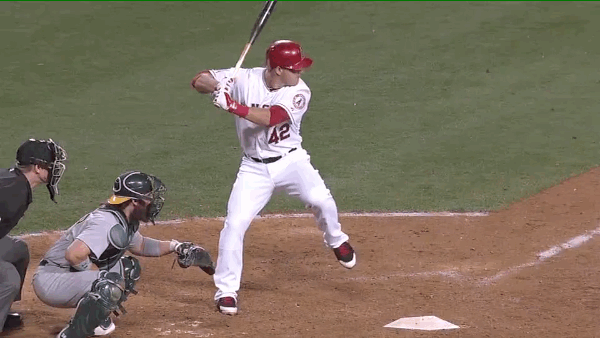

The first thing to draw attention to is how their hands move as they load and take their steps. Cabrera has a down-back-up circle load with his hands, and Trout’s hands barely move at all, instead cocking toward his head as he steps forward. Votto moves his hands down and back slightly as he picks up his foot, but as he moves forward, his hands are moving forward with his stride.
Though they are all different stylistically, the common quality is that they do not push the hands back as they move their bodies forward. Even Cabrera, whose hands move back more than the other two, goes more down and up than back with the knob of the bat. The hands stay connected to the stride and move forward before starting to deliver the swing, allowing the shoulders to be in a relaxed position as the bat begins to be accelerated.
None of these three turns his hips or shoulders back as they load or step. To load their trunk for rotation, they instead crunch the front side slightly as they stride while the back side stays tall. The first move with the core at the start of the swing is for the back side to crunch and the front side to release that crunch, so the position reverses without the head changing position relative to the base. The shoulders stay relatively square to the plate during this initial move, as well.




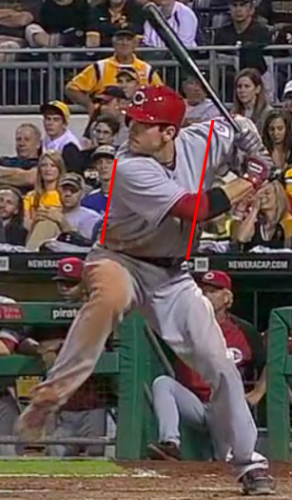

This movement is coupled with the hips beginning to rotate into the swing, creating lag between the lower and upper halves of the body. This hip rotation is initiated from the top of the legs down, with the trunk turning the back knee and foot in sequence, respectively. The front heel plants firmly on the ground, where the weight on the front side remains throughout the rest of the swing.
On Cabrera’s swing, you can even see his front toes come up slightly as he makes contact with the ball and proceeds to follow-through. Trout’s front foot rolls to some extent toward the third base dugout after contact, though his weight is also driven through the heel into the ground.
In the upper half of the body, as the back side of the core begins to crunch, the hands make their first moves down behind their bodies, not forward:
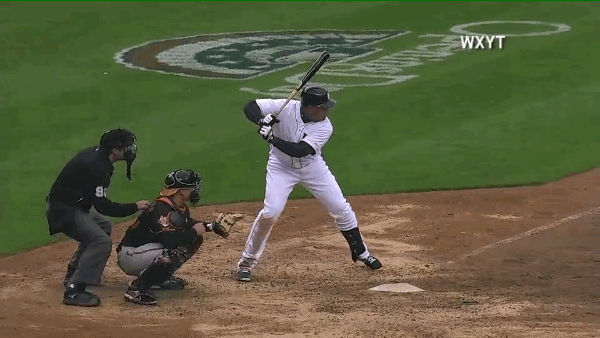


By the time the back elbow is at the same level and horizontal position as the back hip, the hands have already leveled off and begun to travel toward the pitcher with a slight incline. During this movement with the hands, the barrel stays tight to the back shoulder, dropping almost directly down on the same path as the hands without much of a loop back toward the catcher.
As the bat approaches contact, it is coming on a slight upward plane, with the back shoulder working under the front shoulder. The hands are in a palm in-palm out (or palm toward the body-palm away) position near contact, reflecting the vertical path of the bat approach—notice how visible the backs of the front batting gloves are:



After contact, the arms continue out toward the field on the same path. The back arm does not roll over the front arm. Instead there is a clear gap maintained between the arms from the side view into full extension of both arms. Trout and Cabrera continue to hold this gap even as the barrel comes back to their bodies in the follow-through. Votto’s top hand comes over the bottom hand after extension, but it rolls back to the body rather than across it.



Our next group: the little engines that could. To find three hitters for a similar comparison, I used (reported, though probably not completely honest) height and weight data from the Fangraphs database to narrow the options. To make a scientific process out of unscientific data, I pooled together all the hitters with a listed height of 5-foot-9 or less. I then found which of this group had a full season (qualified for the batting title) in 2012 or 2013 with a positive offensive contribution according to Fangraphs’ Batting Runs.
This left me with four player-seasons: Dustin Pedroia’s 2013, Shane Victorino’s 2013, Norichika Aoki’s 2012 and Jose Altuve’s 2012 seasons. To keep the groups symmetrical, I dropped Victorino from the analysis, as he represented the highest reported weight of the four.
To account for the fact that these guys were not as consistent across both 2012 and 2013, I pulled up swings from the specific year that came up in the search. The analysis will remain observational for comparison to the top hitters examined above.
This group is a surprisingly diverse sample to analyze. In Aoki, we have a spray hitter who has succeeded by using his speed and bat control to produce runs. Altuve also is a contact hitter with a bit more pop on occasion, while Pedroia makes a living crushing baseballs into and over the large structure in left field of his home park.



All three move their hands forward with their strides, the same as Votto, Trout and Cabrera. Pedroia’s hands move back slightly as he picks up his foot, but as he continues moving forward, his hands are clearly riding with him.
As for the movement of the trunk both during the load and initial forward phase of the swing, these hitters start to differ from the top three. Pedroia loads up his core by turning his shoulders back with only a slight side-bend in his obliques. However, the first portion of his swing does include the same bending of his right side, bringing his right shoulder down under his left. He simply does it while his core and shoulders are turning forward, getting back to square in a similar position as the big guys:

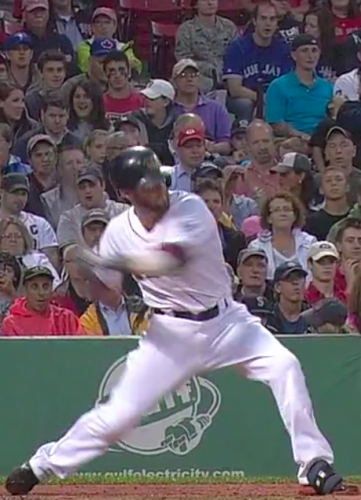
Aoki moves similarly to the big three, starting in a front crunch and moving into a back crunch. He also incorporates a bit more of a turn as he makes his initial move into the swing, reaching the same position as Pedroia:


Altuve appears to utilize the most similar move to his double-sized counterparts, though he does not side-bend to the same degree in either direction as the others in this group or the “freaks.” As a result, there is less hip rotation before his shoulders begin to turn through:

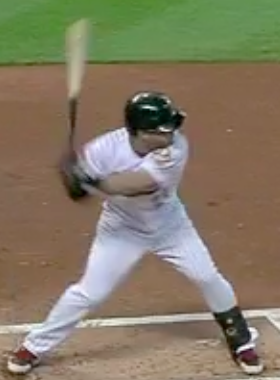
Referring back to the moving images above, all three of these hitters turn their hips first prior to their back knees and feet turning. Pedroia is the most obvious, starting his hips before his front foot is even on the ground while his knee stays facing the first-base dugout. Aoki’s knee starts to turn close to the same time as his core, but his core quickly drives out in front to pull the rest of the lower half into the move (watch the belt buckle). In the Altuve clip, the back knee bends sideways just as the hips start to rotate, making it slightly less obvious. Watching his back foot brings much more clarity to the sequence of the turn, as it lags significantly behind the hip turn.
Like Trout, et al., all three of the little guys plant their front heels into the ground as they get into their swings. Also like Trout, each of these three have their front toes come off the ground before rolling to the outside of the heel after contact.
Moving up the body we can see the last portion of the comparison in the hand and bat path. As the following images illustrate, Pedroia, Aoki and Altuve let their hands work down behind them before coming forward toward the pitcher. Aoki’s hands start coming forward slightly higher relative to his belt line than the others, though it should be noted he is hitting a pitch right around belt level. Pedroia’s hands push in front of his back elbow earlier than the others, but again the first move is still down. Altuve’s initial move with the hands and bat looks almost identical to the primo group above.



The barrel follows the hands, sliding down the back shoulder to the level of the ball before swinging up to contact. Here is the same still shot at contact, showing the position of the hands above the barrel and following the same palm in-palm out description as above. Aoki’s hands are the closest to palm up-palm down, which likely is related to the fact that his hands come around his body on the follow-through more than the other five hitters examined here.



And finally, here are the swings just from contact to follow-through:



You can see Pedroia and Altuve move out to full extension and hold the gap between the arms well past contact. Aoki does not have the same visible gap for very long, but he also does not roll his left arm over his right until he is fully extended with both arms.
Apart from the few exceptions mentioned, the undersized hitters have a whole lot in common with the top hitters in the game from a mechanical perspective. These are just six hitters, to be sure. But if Cabrera, Trout and/or Votto does everything wrong and still hits, then these other five may have to be freaks, too. We should have expected to find someone out of this group that did something noticeably different if we are to believe there is a better way.
To discredit what the best in the game do as a fluke is not justified when multiple hitters share the same traits, particularly hitters of this caliber and skill set. In these six, we have three who have outperformed everyone on the planet for two full seasons and three who overcome size disadvantages to put up more than respectable numbers at a level where everyone around them has a bigger engine. Not everyone achieves hitting success using the same strategy or mechanics, but an awful lot of explaining needs to be done to prevent a player from emulating the common movements of the best big-league hitters.
I have my own theories and understandings of why some movements are more optimal than others, but that doesn’t really matter. Logically speaking, if many of the best players in the game swing in similar fashions, there’s a high probability it is a more advantageous approach, especially when it is in opposition to what is commonly taught. If you want exceptional results, you must look at the exceptional for guidance.
Observe, rather than be blinded by a rigid set of beliefs. As Bruce Lee once wrote: “To see a thing uncolored by one’s own personal preferences and desires is to see it in its own pristine simplicity.”
Resources and References
- Lee, Bruce. Tao of Jeet Kune Do. Expanded Edition, 2011, Pg. 12.
- Stats collected from FanGraphs; current as of April 27, 2014.
- Many thanks to Jeff Zimmerman for the height and weight data.


Interesting general point, but I am not enamored of your selection of players. I would have selected 3 guys with high batting runs totals who never walk — a guy like Votto gets a decent chunk of his value from his BBs, yet I doubt that his hitting mechanics contribute to that.
it is also possible that all MLB hitters have similar mechanics — all MLBers are elite hitters, in the grand scheme of thing. I would have liked to see you look at some guys who can’t hit a lick and see how their mechanics vary from the mechanics of the best hitter. As it stands, you are selecting on the dependent variable, which makes comparative analysis highly problematic.
Your first is an intriguing proposition, but I think walk rate is too interdependent with hitter ability to make a reasonable sample out of those conditions. A hitter at the top of the league will be subject to greater caution from opposing pitchers, as well as having a possible advantage by being able to react to the ball later with a presumably more efficient swing. Who would you suggest? Maybe I could do a follow-up.
I agree that all major leaguers must be doing something right, even those who are only short-time recipients of big league playing time. There are visible differences between the best hitters and the worst hitters in terms of mechanics, but that is a bit outside the scope of this article. Most importantly to me, I would like to shy away from portraying players in a negative light unless absolutely necessary. I don’t presume to think everyone reads my articles, but I respect the hard work players put in, and they don’t need me pointing out their “flaws” to everyone in the public sphere.
I would argue that the lack of a true control group is the problem with looking at anything to do with professional baseball. At some point I’ll finish my project looking at a few hundred amateur hitters from the 2007 draft, which is as close as I can come to having a great sample. Any thoughts would be welcome.
Perhaps looking at the mechanics of various ages of youth league hitters could provide a nice contrast with which to compare. I’d be unsure of how to obtain such data but it would follow that a talented young hitter who knows nothing of hitting mechanics and hasn’t been working on his naturally gifted swing for very long should also show some similarities to the proffesionals whom you already analyzed.
You’re the reason for anything resembling an understanding of hitting mechanics that I have.
You and Doug Thorburn of BP have made me a better coach.
Thanks for all your work.
I’m glad it’s been helpful for you. Thanks for the nice words!
I’m surprised anyone says Cabrera has “freak” mechanics. I don’t analyze swings for a living, but I’ve still seen many many thousands of swings and have my opinions of what looks unusual. Cabrera looks pretty normal. Like spot-on 50th percentile normal.
One thing from my own personal mechanical training – I’ve always had the best success generating a good swing path when my forearms form a roughly 90 degree angle after I load. Votto’s are basically a straight line and the others are all well over 90 degrees too. I wonder if professional, mutant strength helps them do some things that aren’t ideal for us normal folk. The little guys appear to have a lesser angle than the big guys. Obviously, this is a little thing to focus on, but it’s one of my personal cues, so I notice it in others.
I agree regarding the confusion over Cabrera’s mechanics, though I do think he does a lot of things differently than most hitters. He doesn’t load his hands the same as just about everyone else in the game (the dreaded “hitch”), and he also leans forward in a much more aggressive posture than most of the hitters in the league. No load back, picks up his front leg and immediately moves forward. I can see the reasons people think he’s so different, but I disagree with those who say he’s inefficient. I know of at least a few professional coaches who think he has a terrible swing, and even Cabrera himself has been quoted saying other players shouldn’t mimic him, which I hate (Wall Street Journal article from ).
I’m like you regarding arm angle; my swing gets too pushy when the angle between my forearm and upper arm gets much smaller than 90 degrees. Guys like Votto (e.g. Adrian Beltre) can start a bit more narrow as long as it doesn’t interfere with the back elbow dropping down independently before the hands attack. I think it’s similar to how some pitchers short-arm the ball without losing good, loose arm action. For some guys it’s ruinous; others it works just fine. Though I would say Votto can get a bit “pushy” with his swing sometimes, possibly a byproduct of the position his arms start in. He’s also a R/L combo, making good arm action a tough thing to accomplish from the weak arm.
http://online.wsj.com/news/articles/SB10001424052702303464504579107291140308858
Forgot to add the WSJ link
http://health-care-and-agility.blogspot.com/
Seriously?
Great article!
I don’t think it would make too much difference who was chosen for comparison from the better hitters in MLB because of other factors such as vision and the decision making process. It makes sense to me that the best hitters have everything working well in concert. For the best hitters, it would be pretty difficult to isolate just how much the mechanics contribute to the end result minus the other factors.
To me these swings all look pretty similar once you get past personal idiosyncrasies, especially at the point of contact. It may be that small differences are due to each individual’s specific body makeup and fitness. Another interesting project may be to look at potential differences when a hitter is trying to make up for an injury, as with Cabrera last year.
Thanks! I’ll think about a way to look into injuries a bit more. Maybe I could do some more exploration of shoulder injuries and wrist injuries sapping power on returning to regular play.
Pedroia’s swing is radically different from the other five. He has tremendous forward motion, an equal vertical drop, and winds up too low to lock his front knee.
So that overrides all the similarities? I’m not sure momentum and bending his knees more makes him an outlier when all the other pieces look so alike.
Pedroia is also hitting an off-speed pitch in this shot, which only accentuates the sink into his legs. The front leg movements are still the same as the others; the front knee doesn’t need to be locked for the leg to be stable.
Forward movement is probably the first thing a hitting coach takes out of a kids swing, with the object of replacing it with rotation. Pedroia is so small that he apparently finds it necessary to add motion to rotation in getting to major league power levels. More power to him, but this is a radical departure from the other five swings.
Not locking up the front leg causes a great loss of power as power bleeds over drift. It also causes other problems, but Pedroia has already committed them so no further damage done. The other players of which I am aware that do not lock the leg at point of contact are Ichiro and Saltalamachia. I’m not saying that it can’t be done, but why would you?
Clemente had the greatest forward motion of any player in history. He did just about everything else right. Bottom line is, are you successful? But I would guess that were all players to hit as Pedroia does batting and slugging percentages would drop like a stone.
Agree with James – even in this company, Pedroia looks like an outlier. Coming up a lot of people thought he wasn’t much of a prospect because his swing couldn’t possibly play in the bigs; I don’t think that was said of the others. (Then … laser show!) I suspect hitters with really extraordinary hand-eye coordination (even by MLB standards) can do things differently, and I’d point to a less-good hitter, Jose Iglesias, as an example. Who else has ever succeeded by deciding to hit ball down the foul lines?
What struck me when looking at Pedroia’s swing again is how quickly he gets the right side of his torso stable just before contact. With the long stride he takes, it’s amazing he gets himself to almost a straight line from his right shoulder to his right knee (Cabrera’s swing is amazing in this regard; not only are his torso and thigh “frozen” before impact, but he barely even moves his lower back leg)
Great article and awesome gifs. My one nit is the players front foot lands ball first and then the hip pivot brings the front heel down, no?
No argument here, except that sometimes the hips turn before the foot is down at all, and other times they don’t turn until the heel is all the way down. Just a matter of timing.
http://bitly.com/1hJjOxR
I love this article, very fascinating.
It’s a shame we are lmited by video quality. I’d be interested in an analysis of the swings of players who were somewhat different stylistically. Albert Pujols, who I consider to have the perfect swing, as compared against incredible hitters with funky swings, like Vladimir Guerrero.
I would also wonder with a guy like Cal Ripken Jr, who was effective despite myriad batting stances, what he did consistently (among his many inconsistencies) that made him a great hitter.